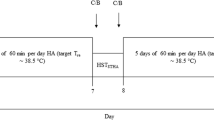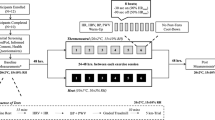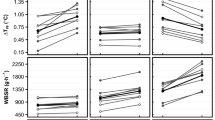Abstract
The purpose of this work was to investigate adaptation and decay from short-term (5-day) heat acclimation (STHA). Ten moderately trained males (mean ± SD age 28 ± 7 years; body mass 74.6 ± 4.4 kg; \( \dot{V}_{{{\text{O}}_{ 2{\text{peak}}} }} \) 4.26 ± 0.37 l min−1) underwent heat acclimation (Acc) for 90-min on 5-days consecutively (T a = 39.5°C, 60% RH), under controlled hyperthermia (rectal temperature 38.5°C). Participants completed a heat stress test (HST) 1 week before acclimation (Acc), then on the 2nd and 8th day (1 week) following Acc (T a = 35°C, 60% RH). Seven participants completed HSTs 2 and 3 weeks after Acc. HST consisted of 90-min cycling at 40% peak power output before an incremental performance test. Rectal temperature at rest (37.1 ± 0.4°C) was not lowered by Acc (95% CI −0.3 to 0.2°C), after 90-min exercise (38.6 ± 0.5°C) it reduced 0.3°C (−0.5 to −0.1°C) and remained at this level 1 week later (−0.5 to −0.1°C), but not two (0.1°C −0.4 to 0.5°C; n = 7) or 3 weeks. Similarly, heart rate after 90-min exercise (146 ± 21 b min−1) was reduced (−13: −6 to −20 b min−1) and remained at this level after 1 week (−13: −6 to −20 b min−1) but not two (−9: 6 to −23 b min−1; n = 7) or 3 weeks. Performance (746 s) increased 106 s: 59 to 152 s after Acc and remained higher after one (76 s: 31 to 122) but not two (15 s: −88 to 142 s; n = 7) or 3 weeks. Therefore, STHA (5-day) induced adaptations permitting increased heat loss and this persisted 1 week but not 2 weeks following Acc.










Similar content being viewed by others
References
Adam JM, Fox RH, Grimby G, Kidd DJ, Wolff HS (1960) Acclimatization to heat and its rate of decay in man. J Physiol 152:26P–27P
Armstrong LE (1992) Keeping your cool in Barcelona: the effect of heat, humidity and dehydration on athletic performance, strength and endurance. U.S. Olympic Committee, Colorado Springs, pp 1–29
Armstrong LE, Maresh CM (1991) The induction and decay of heat acclimatisation in trained athletes. Sports Med 12(5):302–312
Barnett A, Maughan R (1993) Response of unacclimatized males to repeated bouts of exercise in the heat. Br J Sports Med 27:39–44
Bass DE, Kleeman CR, Quinn M, Henschel A, Hegnauer AH (1955) Mechanisms to acclimatization to heat in man. Medicine 34:323–380
Bruck K, Olschewski H (1987) Body temperature related factors diminishing the drive to exercise. Can J Physiol Pharmacol 65:1274–1280
Buget A, Gati R, Souburan G (1988) Seasonal changes in circadian rhythms of body temperature in humans living in a tropical dry climate. Eur J Appl Physiol 58:334–339
Buono MJ, Heaney JH, Canine KM (1998) Acclimation to humid heat lowers resting core temperature. Am J Physiol 274:R1295–R1299
Burge CM, Skinner SL (1995) Determination of hemoglobin mass and blood volume with CO: evaluation and application of a method. J Appl Physiol 79:623–631
Convertino VA, Greenleaf JE, Bernauer EM (1980) Role of exercise and thermal factors in the mechanism of hypervolemia. J Appl Physiol 48:657–664
Cotter JD, Patterson MJ, Taylor NAS (1997) Sweat distribution before and after repeated heat exposure. Eur J Appl Physiol 76:181–186
Creasy R (2002) Post-exercise sauna bathing does not improve 2000-metre rowing performance. BPhEd, University of Otago, Dunedin
Fellman N (1992) Hormonal and plasma volume alterations following endurance exercise. Sports Med 13:37–49
Givoni B, Goldman RF (1972) Predicting rectal temperature response to work, environment, and clothing. J Appl Physiol 32:812–822
Gore CJ, Hopkins WG, Burge CM (2005) Errors of measurement for blood volume parameters: a meta analysis. J Appl Physiol 99:1745–1758
Green CC, Mavaddat L, Watts K, Best M, Taylor R, O’Driscoll G (2002) Effect of lower limb exercise on forearm vascular function: contribution of nitric oxide. Am J Physiol Heart Circ Physiol 283:H899–H907
Greenleaf JE, Greenleaf CJ (1970) Human acclimation and acclimatization to heat: compendium of research. Biotechnology division. National aeronautics and space administration. Ames research center, Moffett Field
Hargreaves M, Febbraio M (1998) Limits to exercise performance in the heat. Int J Sports Med 19:S115–S116
Harrison MH (1985) Effects of thermal stress and exercise on blood volume in humans. Physiol Rev 65:149–209
Hayden G, Milne HC, Patterson MJ, Nimmo MA (2004) The reproducibility of closed-pouch sweat collection and thermoregulatory responses to exercise-heat stress. Eur J Appl Physiol 91:748–751
Henschel A, Taylor HL, Keys A (1943) The persistence of heat acclimatisation in man. Am J Physiol 140:321–325
Horowitz M (2002) From molecular and cellular to integrative heat defense during exposure to chronic heat. Comp Biochem Physiol Mol Integr Physiol 475–483
Horowitz M, Meiri U (1993) Central and peripheral contributions for the control of heart rate during heat acclimation. Pflugers Arch 422:386–392
Houmard JA, Costill DL, Davis JA, Mitchell JB, Pascoe DD, Robergs RA (1990) The influence of exercise intensity on heat acclimation in trained subjects. Med Sci Sports Exerc 22:615–620
Kampmann B, Brode P, Schutte M, Griefahn B (2008) Lowering of resting core temperature during acclimation is influenced by exercise stimulus. Eur J Appl Physiol 104:321–327
Lamb DR, Murray R (eds) (1988) Perspectives in exercise science and sports medicine: prolonged exercise, vol 1. Benchmark Press, Inc., Indianapolis
Levi E, Vivi A, Hasis Y, Tassini M, Navon G, Horowitz M (1993) Heat acclimation improves cardiac mechanics and metabolic performance during ischemia and reperfusion. J Appl Physiol 75:833–839
Levi E, Vivi A, Hasis Y, Navon G, Horowitz M (1997) Chronic heat improves mechanical and metabolic response of trained rat heart on ischemia and reperfusion. Am J Physiol H2085–H2094
Lind AR, Bass DE (1963) Optimal exposure time for development of acclimatization to the heat. Fed Proc 22:704–708
Mirit E, Gross C, Hasin Y, Palmon A, Horowitz M (2000) Changes in cardiac mechanics with heat acclimation: adrenergic signaling and SR-Ca regulatory proteins. Am J Physiol Regul Integr Comp Physiol 279:R77–R85
Montain SJ, Coyle EF (1992) Fluid ingestion during exercise increases skin blood flow independent of increases in blood volume. J Appl Physiol 73:903–910
Morel F, Doucet A (1986) Hormonal control of kidney functions at the cell level. Physiol Rev 66:377–468
Myhre LG, Dill DB, Hall FG, Brown DK (1970) Blood volume changes during three-week residence at high altitude. Clin Chem 16:7–14
Nielsen B, Hales JRS, Strange S, Christensen JW, Saltin B (1993) Human circulatory and thermoregulatory adaptations with heat acclimation and exercise in a hot, dry environment. J Physiol 460:467–485
O’Sullivan SE (2003) The effects of exercise training on markers of endothelial function in young healthy men. Int J Sports Med 24:404–409
Pandolf KB (1998) Time course of heat acclimation and its decay. Int J Sports Med 19:S157–S160
Pandolf KB, Burse RL, Goldman RF (1977) Role of physical fitness in heat acclimatisation, decay and reintroduction. Ergonomics 20:399–408
Patterson MJ (1999) The effect of heat acclimation on body-fluid regulation. PhD, University of Wollongong, Wollongong
Patterson MJ, Stocks JM, Taylor NAS (2004) Sustained and generalised extracellular fluid expansion following heat acclimation. J Physiol 559:327–334
Saat M, Sirisinghe RG, Singh R, Tochihara Y (2005) Decay of heat acclimation during exercise in cold and exposure to cold environment. Eur J Appl Physiol 95:313–320
Sakurada S, Shido O, Sugimoto N, Fujikake K, Nagasaka T (1994) Changes in hypothalamic temperature of rats after daily exposure to heat at a fixed time. Pflugers Arch 429:291–293
Sawka MN (1983) Hypohydration and exercise: effects of heat acclimatisation, gender and environment. J Appl Physiol 55:1147–1153
Sawka MN, Hubbard RW, Francesconi RP, Horstsman DH (1983) Effects of acute plasma volume expansion on altering exercise-heat performance. Eur J Appl Physiol 51:303–312
Sawka MN, Convertino VA, Eichner RE, Schnieder SM, Young AJ (2000) Blood volume: importance and adaptations to exercise training, environmental stresses, and trauma/sickness. Med Sci Sports Exerc 32:332–348
Senay LC, Mitchell D, Wyndam CH (1976) Acclimatization in a hot, humid environment: body fluid adjustments. J Appl Physiol 40:786–796
Shapiro Y, Hubbard RW, Kimbrough CM, Pandolf KB (1981) Physiological and hematologic responses to summer and winter dry-heat acclimation. J Appl Physiol 50:792–798
Shido O, Sugimoto N, Tanabe M, Sakurada S (1999) Core temperature and sweating onset in humans acclimated to heat at a fixed daily time. Am J Physiol R1095–R1101
Shvartz E, Saar E, Meyerstein N, Benor D (1973) A comparison of three methods of acclimatization to dry heat. J Appl Physiol 34:214–219
Strydom NB, Williams CG (1969) Effect of physical conditioning on the state of heat acclimation on Banto labourers. J Appl Physiol 27:262–265
Taylor NAS (2000) Principles and practices of heat adaptation. J Hum Environ Syst 4:11–22
Thomsen JK, Fogh-Andersen N, Bulow K, Devantier A (1991) Blood and plasma volumes determined by carbon monoxide gas, 99mTc-labelled erythrocytes, 1251-albumin and the T 1824 technique. Scand J Clin Lab Invest 51:185–190
Turk J, Worsley DE (1974) A technique for the rapid acclimatisation to heat for the army. Army personnel research establishment, Ministry of Defence, Farnborough, pp 1–15
Weller A, Linnane D, Jonkman A, Daanen H (2007) Quantification of the decay and re-induction of heat acclimation in dry-heat following 12 and 26 days without exposure to heat stress. Eur J Appl Physiol 102:57–66
Williams CG, Wyndham CH, Morrison JF (1967) Rate of loss of acclimation in summer and winter. J Appl Physiol 22:21–26
Wyndham CH, Jacobs GE (1957) Loss of acclimatization after six days of work in cool conditions on the surface of a mine. J Appl Physiol 11:197–199
Acknowledgments
Special thanks are given to the participants in this study and the technical expertise provided by Mrs R. McKay and Miss D. Wilson. This work was supported by grants from the Australian Defence Science Technology Organisation and School of Physical Education, University of Otago, New Zealand.
Author information
Authors and Affiliations
Corresponding author
Additional information
An erratum to this article can be found at http://dx.doi.org/10.1007/s00421-009-1224-1
Rights and permissions
About this article
Cite this article
Garrett, A.T., Goosens, N.G., Rehrer, N.G. et al. Induction and decay of short-term heat acclimation. Eur J Appl Physiol 107, 659–670 (2009). https://doi.org/10.1007/s00421-009-1182-7
Accepted:
Published:
Issue Date:
DOI: https://doi.org/10.1007/s00421-009-1182-7




